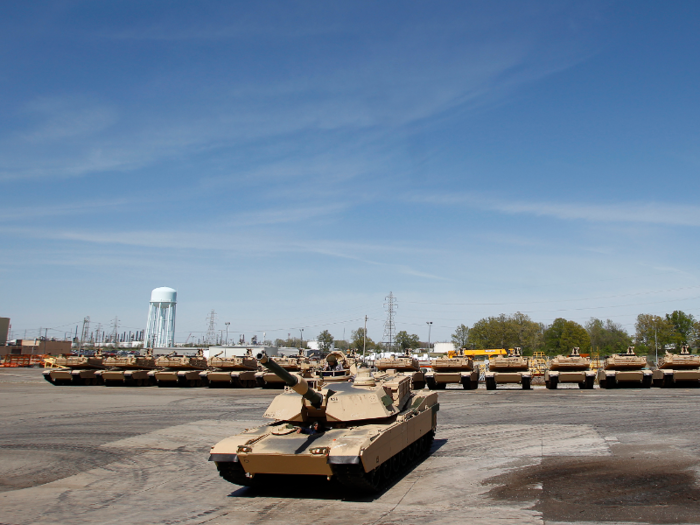
The facility opened in 1942 and soon began to build and test vehicles to be sent to the Pacific and European theaters. It built M-5 Light Tanks and T-26 Pershing tanks, according to the website Global Security. By the end of the war it had processed 100,000 combat vehicles.
The facility is owned by the US Army and operated by a contractor.

An expansion began after the Korean War broke out in 1950. The Army built new structures, including two massive warehouses that each had 115,000 square feet of storage, according to an official history of the site.
Construction fell off sharply after the war and didn’t pick up much during the Vietnam War.

The Army introduced the M-1 Abrams in 1980 and called it a "supertank" that would be faster, better armored, and have more firepower than is predecessors.
The early M-1 Abrams tanks weighed 60 tons, carried a 105 mm cannon, and could speed across fields at 30 mph. The armor used a "new super alloy, composite-material" to protect against rockets and artillery, according to the history.
Chrysler Defense began production of the M-1 tanks at Lima in 1979.
In 1980, the first M-1 Abrams rolled out of Lima. It was named "Thunderbolt," in homage to the name Gen. Creighton Abrams gave to his tanks in World War II, according to Global Security.

General Dynamics Land Systems bought Chrysler Defense in 1982. The plant became the sole US tank factory in when the Detroit Arsenal Tank Plant closed in 1996.
The deep sequestration budget cuts nearly shuttered the plant in 2012, and tank production languished under the Obama administration, which oversaw counter-insurgency wars in Iraq and Afghanistan, where a large force of tanks wasn't needed.
In 2017, the Joint Systems Manufacturing Center was producing about one upgraded M-1 tank a month; a year later it was producing about 11, according to the Los Angeles Times.
Two factors have seen the Lima's tank plant roar back to life: Trump's massive defense-spending hikes and the US's assessment that rivalries with China and Russia are now the country's foremost threat.
Deterring a major power like them may rely on the US Army fielding the upgraded, 80-ton Abrams tanks now rolling off Lima's assembly lines.
 Welcome to the white-collar recession
Welcome to the white-collar recession Singapore Airlines was ordered to pay a couple compensation for 'mental agony' after they complained their business-class seats didn't automatically recline
Singapore Airlines was ordered to pay a couple compensation for 'mental agony' after they complained their business-class seats didn't automatically recline A 101-year-old woman keeps getting mistaken for a baby on flights and says it's because American Airlines' booking system can't handle her age
A 101-year-old woman keeps getting mistaken for a baby on flights and says it's because American Airlines' booking system can't handle her age “Wish to follow in the footsteps of PM Modi!” ‘Anupamaa’ star Rupali Ganguly joins BJP
“Wish to follow in the footsteps of PM Modi!” ‘Anupamaa’ star Rupali Ganguly joins BJP
 “Wish to follow in the footsteps of PM Modi!” ‘Anupamaa’ star Rupali Ganguly joins BJP
“Wish to follow in the footsteps of PM Modi!” ‘Anupamaa’ star Rupali Ganguly joins BJP
 Assassin’s Creed Mirage on iPhone 15: Killer game to debut on Pro and iPad on June 6
Assassin’s Creed Mirage on iPhone 15: Killer game to debut on Pro and iPad on June 6

Copyright © 2024. Times Internet Limited. All rights reserved.For reprint rights. Times Syndication Service.